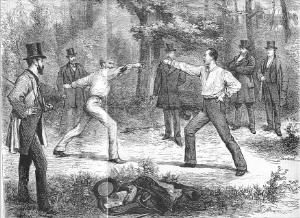Journal of Non-lethal Combatives,
March 2000
The Sentiment of
the Sword: A Country-House Dialogue,
by Sir Richard Francis Burton, edited, with Notes, by A.
Forbes Sieveking (London: Horace Cox, 1911)
INTRODUCTION
As a book, Burton's The Sentiment of the Sword
is comparatively rare. For example, it was not listed in Fawn Brodie's
bibliography of Burton's works and the Library of Congress does not list
it in its online catalogue. Therefore it has been reprinted here almost
in its entirety. (Exceptions included the omission of an index irrelevant
to an online document and a preface by Theodore A. Cook that had little
to say.)
Structurally, The Sentiment of the Sword
is not an easy book to read, as the prose is Victorian, there are no illustrations,
and the author assumed readers were fluent in French and conversant in
Latin. Nonetheless, Chapters 6 and 7 in particular contain much of interest
to the modern swordsman while Chapter 2 provides a good introductory history
of French and Italian schools of fence. And of course gems of insight sparkle
throughout.
Please include attribution to http://ejmas.com
whenever citing this text, unless of course you have a copy of the original
book or its manuscripts. The text used here was provided by Paul Nurse,
Ph.D., and keyboarded by Joseph R. Svinth. Linkage to these sites is authorized,
but copying the text to your site without the permission of the editor
will be viewed with considerable disfavor.

TABLE OF CONTENTS
THE
FIRST EVENING
Foreword by Editor (A. Forbes Sieveking)
-
Introduction
-
Point and edge amongst Ancients and Primitive Peoples
-
History and Development of Sword
-
Early Fencing Treatises and Technicalities -- Simplification
-- Italian school and Names of Parries -- Natural Parries -- Lines and
Attack and Defense
-
How to Teach Fencing
THE
SECOND EVENING
-
The Audience
-
Fencing for Women
-
English Dilettantism
-
Treatises -- The Alphabet and Language of the Sword
-
Fencing in the XVth and XVIth Centuries -- Early
Italian, French, and German Writers
-
Spanish School
-
Early Neapolitan and Italian Schools
-
Giuoco Misto of Modern Italians
-
Bologna City and Fencing
-
Blasco Florio on Spanish, Neapolitan, and Sicilian
Schools
-
Ariosto and Tasso on Duels -- French System
-
Aspects of French Fencing
-
Locke on Fencing -- Utilitarianism
-
Bazancourt on the Strength of a Swordsman
-
The Natural and Artificial Systems
THE
THIRD EVENING
-
Bayonet Exercise
-
Attacks and Parries, Simple and Compound
-
Same Elucidate
-
Ditto
-
Cardinal Virtues of Sword
-
Practical Demonstration of Lesson
-
Ditto
-
Axioms of the Science
THE
FOURTH EVENING
-
Prelude
-
Method of Instruction
-
Disadvantages and Delays of Old Systems
-
Buffon and Style -- in Fencing
-
Ditto
-
Heresy
-
Platron-work
-
Ditto
THE
FIFTH EVENING
-
The Assault: Its Axioms and Faculties
-
Upper and Lower Lines
-
Ditto
-
Girard Thibaust and Face Thrusts
-
The Retreat
-
Ditto
-
The Universal Parry -- Individuality in the Parry
-
The Ripost and Remise
-
Summing-up
THE
SIXTH EVENING
-
Le Sentiment du Fer
-
"Giving the Sword."
-
Ditto
-
Le Sentiment du Regard: Thibaust
-
Combination of Both Sentiments
-
The Pressio, Flanconnade, Battement, and Croisé
-
The Academic v. The Natural Fencer
-
Grace and Inspiration
-
Origin of the Foil; the Plastron and Mask; Jacket,
Shoe, and Glove; Leather Armour
-
Feints
THE
SEVENTH EVENING
-
Frenchman v. Neapolitan
-
Attacks
-
A Fatal Habit -- Remaining on Guard -- Bayonet Exercise
-
The Stop-Thrust and Time-Thrust
-
Bottes Secrêtes and Coup de Jarnac
-
Misjudging an Enemy -- Cowardice and Nervousness
-
The Unbuttoned Weapon
-
The Gaucher, or Left-handed Fencer
-
Self-consciousness and Savoir faire
THE
EIGHTH EVENING
-
Prelude
-
The Relative Merits of Sword and Pistol
-
English Feeling about the Duel
-
Fencing and Personal Utility
-
Duties of a Second
-
Parrying with the Left Hand, and other Irregular
Parries
-
Responsibilities of a Second
-
The Corps-à-Corps -- Fair Play
-
The Right to Rest in the Duel -- The "Point of Honour"
-
A Succession of Duels
THE
NINTH EVENING
-
Means of Attack and Defence -- Youth and Age
-
Length of Arm
-
Degrees of Proficiency in Arms
-
Neophyte's Preparation for Duel -- The Instinctive
Position: Beauty on Guard
-
Phrenology and Character -- "Defend and Threaten,"
i.e., Retreat and Extend Sword
-
Lunge to the Rear
-
Advice to Pupil of Moderate Skill in Arms
-
Analysis of Process -- Mastering Opponent's Sword
-
The Man of Sanguine Temperament
-
Where Both Combatants Equally Skilled -- Distrust
Your Adversary -- The Foil that "Buttons," and the Point that Kills
-
Conclusion
JNC Mar 2000

